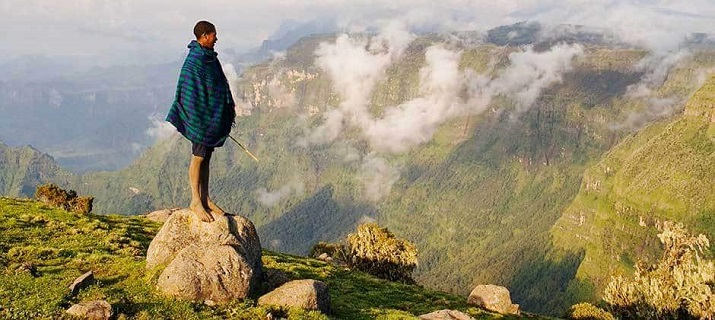
Ethiopia Harari travel with tourist Visa
Consisting of the walled city of Harar and its immediate environs, Harari is essentially a modern revival of the autonomous city-state of Harar, which was one of the most powerful regional political entities from the 16th until the late 19th century, when it was co-opted into Abyssinia by Menelik II. The state covers an area of roughly 350 square km and supports a population estimated at 215,000, of which some 131,000 are city dwellers. Roughly half of the population is Oromo, with the Amhara accounting for another 33% and the Harari only 7%. Despite Harar's reputation as the home of Islamic Ethiopia, roughly 40% of its population is Christian. The lush farmland around Harar is known for its chat and coffee plantations, but other major crops include sorghum, maize and oranges.
Get visa to visit Ethiopia Harari
Ethiopia Oromia travel with tourist Visa
The vast region of oromia covers an area of more than 350,000 square km (almost one-third of the country) and supports a correspondingly large population of over 32.2 million people. Roughly 85% of the regional population is Oromo, and another 10% Amhara. Aside from the 5% who still practise animist or other traditional religions, the regional split between Christian and Muslim is as good as even. The oflicial language of Oromifa is inscribed with Latin script rather than the Arabic characters used elsewhere in the country. With its mostly fertile soils, Oromia is the breadbasket of Ethiopia, producing more than half of the nationh agricultural crop, and it is also home to almost half of its large livestock. Geographically and climatically diverse, Oromia hosts many of Ethiopia's more alluring natural attractions, notably Bale and Awash national parks and the lakes of the Rift Valley and Bishoftu. It is rich in minerals, ranging from gold and platinum to iron ore and limestone. Oromia encircles and is currently governed from Addis Ababa (known as Finfine in Oromifa and sometimes signposted as such within the state). In the year 2000, the administration was oflicially moved to Adama(Nazret), but 2005 protests by the Oromo Peoples Democratic Organization succeeded in moving the offices back to Addis.
Get visa to visit Ethiopia Oromia
Ethiopia Somalia travel with tourist Visa
Named for the distinctive Somali people, who comprise 95% of its population, this is the second largest of Ethiopia's regions, covering an area of 250,000 square km along the Somali border. Much of the region is desert or semi-desert, its vast area, the total population is around 5.3 million. The capital is Jijiga, east of Harar. Almost 99% of the population is Muslim, and most of are pastoralists. The important Wabe Shebelle River runs through the region.
Get visa to visit Ethiopia Somalia
Ethiopia Tigray travel with tourist Visa
Ethiopiai's most northerly region is Tigray, which covers 80,000 square km and is administered from its capital city of Mekele. The population totals more than 5.06 million, of which 95% are Orthodox Christian and the remainder Muslim. The Tigraian people, the dominant ethnic group, are agriculturists who also herd cattle and other livestock. Tigray is drier than other parts of highland Ethiopia, and prone to periodic droughts, but the region is intensively cultivated and in some areas terraced. Tigray has been central to many of the more important events in Ethiopian history, from the adoption of Christianity by the Axumite emperor the 4th century, to the defeat of Italy outside Adwa 1,500 years later. The city of Axum and associated archaeological sites are the main tourist attractions, but the 120 rock-hewn churches scattered throughout the east of the country are also well worth exploring.
Get visa to visit Ethiopia Tigray
Ethiopia Southern Nations, Nationalities and Peoples' Region travel with tourist Visa
Although it smells like the handiwork of an uninspired committee, the name of this 112,323 square km region does provide an accurate reflection of its incredible cultural diversity. The regional population of roughly 17.9 million represents some 45 different ethino-lingustic groups, of which none comprises 20% of the regional population, and only the Sidamo, Gurage and Walaita make up more than 10% each. The regional capital is the modern city of Awassa, set on the shore of the Awassa lake, and much of the region lies in the relatively low-lying Rift Valley and Kenyan border area. The most important crop is coffee. Aside from the Rift Valley lakes, the most popular tourist attraction is the remote cultural tribes of South Omo zone.
Get visa to visit Ethiopia Southern Nations, Nationalities and Peoples' Region
Ethiopia Sidama travel with tourist visa
The Sidama region is one of the regional states (kililoch) of Ethiopia. It was formed on 18 June 2020 from the Southern Nations, Nationalities, and Peoples Region (SNNPR) and transformation of the Sidama Zone after a referendum vote in favour of increased autonomy in the 2019. Towns in Sidama include Awasa, the capital of Sidama and SNNPRS, Yirgalem, Wondogenet, Chuko, Hula, Bona, Bursa, Bensa, and Aleta Wendo. Awasa, the capital of Sidama and SNNPRS, is the largest city, with a population of more than 335,000 people. Sidama has a population of around 3.2 million in 2017 who speak the Cushitic languages Sidama (also known as Sidaamu Afoo).
Sidama region is the leading coffee producing region in Ethiopia. It is generally a fertile area, varying from flat land (warm to hot) to highland (warm to cold). Economically, most are subsistence farmers. Cattle especially is a measure of wealth. The false banana or "enset", along with maize, as well as fermented cows' milk and butter, are the major staple foods of the Sidama.
Get visa to visit Ethiopia Sidama
Other links Read more Travel to Ethiopia






 |
|  |
|  |
|  |
| 